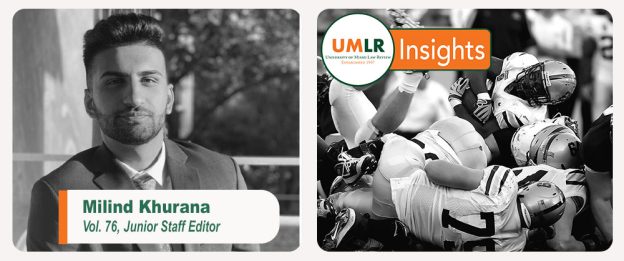Milind Khurana—Recently, the Supreme Court dismissed NCAA practices for the first time in the past thirty-seven years and, to many, signaled a shifting tide in the conversation regarding student-athlete compensation. In NCAA v. Alston, the Court eliminated NCAA rules barring members from providing unlimited educational benefits to student athletes, such as reimbursements and payments for academic-related expenses. Although the Alston ruling that the NCAA violated Section 1 of the Sherman Act by limiting education-related expenses was a relatively narrow one, it comes at the heels of the NCAA adopting interim policies regarding name, image, and likeness (“NIL”) compensation and paints a picture of a changing definition of “amateurism” in U.S. college sports.
So, what does the Alston ruling really mean for student athletes? Interestingly, the ruling itself did not alter much regarding athlete compensation in its entirety, but instead, limits the legal arguments the NCAA may use moving forward. The Court reaffirmed the U.S. Court of Appeals for the Ninth Circuit’s use of the “rule of reason” (a judicial doctrine for determining antitrust violations) in analyzing the NCAA’s college athlete labor practices. Usually, such horizontal restraints are considered “per se” antitrust violations; however, courts have historically used the fact based rule of reason analysis in reference to the NCAA due to the unique structure of the business itself. Specifically, a certain degree of cooperation is needed to properly market college athletics and a balancing test is required to determine whether such cooperation is a violation of the Sherman Act. In applying the doctrine, the Court rejected the NCAA’s argument that their product—amateur college athletics—deserved antitrust deference stemming back to the Court’s 1984 decision in NCAA v. Board of Regents. The NCAA attempted to argue that their product is uniquely tied to the “amateur” status of their student-athletes and that any change in the compensation for athletes would destroy that product. Rejecting this argument, the Court explained that the NCAA already receives large judicial deference regarding antitrust law and failed to show how the NCAA allowing student-athletes to receive academic based compensation would destroy the market for college sports from an economic perspective.
Justice Gorsuch wrote the majority opinion and narrowly tailored the ruling to only impact academic-related benefits (caps on tuition, fees, room, board, books, etc.). Colleges are now also allowed to reimburse athletes for tangible education-related benefits (such as computers and equipment) that are not included in the cost of their attendance. Colleges may still restrict other athletic-related benefits and compensation, such as “pay for play” schemes. Furthermore, because this opinion only banned broad national NCAA rules, colleges and conferences remain free to devise rules of their own regarding education-related benefits.
Justice Kavanaugh, in a somewhat scathing concurrence, heavily criticized the NCAA’s labor practices and stated “[p]rice-fixing labor is price-fixing labor.” His concurrence communicated to the NCAA that they essentially got away with a slap on the wrist. As such, ensuing litigation may force the NCAA to seriously reconsider what the “amateur athlete” means and question their own reasons for not paying players. As Kavanaugh stated, “[t]he NCAA business model would be flatly illegal in almost any other industry in America.”
So, what does this ruling do for other non-education related benefits such as NIL compensation? On its face, nothing. The opinion only concerns itself with education-related benefits. However, the Court’s reasoning, paired with Kavanaugh’s dissent, sends a message that the NCAA’s rationale for not paying student-athletes—amateurism— is breaking down despite the NCAA’s longstanding success defending its practices under this theory.
Following the Alston ruling on June 21, 2021, a number of state law and NCAA policy changes went into effect less than a month later giving athletes new protections and avenues to make money off of their NIL. Current interim NCAA regulations restrict schools or employees of schools from paying athletes directly, state that athletes may not enter “pay-for-play” agreements, and allow athletes to use professional services (agent, lawyer, financial advisor etc.) for their NIL deals. The rest is left largely up to the state laws where the athlete is located. These interim NCAA policies are thought to be put into place until federal NIL legislation is enacted. Currently, there are seven federal NIL bills that have been introduced to Congress that have garnered interest but have not picked up much traction. Meanwhile, twenty-eight states have passed NIL laws that mostly mirror California’s “Fair Pay to Play Act.” South Florida athletes, most notably from the University of Miami, have been making media waves by signing NIL contracts for various amounts of money, largely backed by local billionaire and Hurricanes booster John Ruiz.
Whether you are an advocate or staunch critic of student-athlete compensation, one thing is certain, this ruling has changed college sports forever. The Alston ruling made it clear that any new NCAA defenses to athlete compensation would be met with fierce opposition by the courts. While the landscape may be murky, ensuing legislation on both state and federal levels will aim to provide more clarity on the rights of amateur student athletes. Until then, all we can do is sit back and watch the game unfold.






